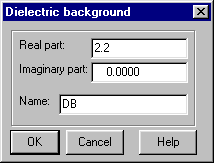The figure below shows a dielectric function typical for a semiconductor in the infrared, visible and ultraviolet spectral region. The very strong structures in the UV can be assigned to electronic interband transitions (critical points in the joint density of states). In the infrared region one is far away from the interband transitions which can be noticed only by an almost constant and real contribution to the dielectric function - the so-called dielectric background. Therefore the optical properties in the infrared can be described quite well by just the sum of a constant and real dielectric function (sometimes called ε∞ where ∞ stands for 'very high frequency' from the infrared viewpoint) and the contributions describing infrared excitations. Free carriers are responsible for the structure in the dielectric function below 1000 cm-1.

Typical dielectric function of a group IV semiconductor (silicon) characterized by an almost constant dielectric function in the mid IR in between strong interband transitions in the UV and free carrier contributions in the far IR.
The dialog to edit a constant susceptibility in SCOUT is the following:

Although the imaginary part of realistic dielectric functions is close to zero in regions of a constant real part you can define a constant imaginary part different from zero for test purposes.